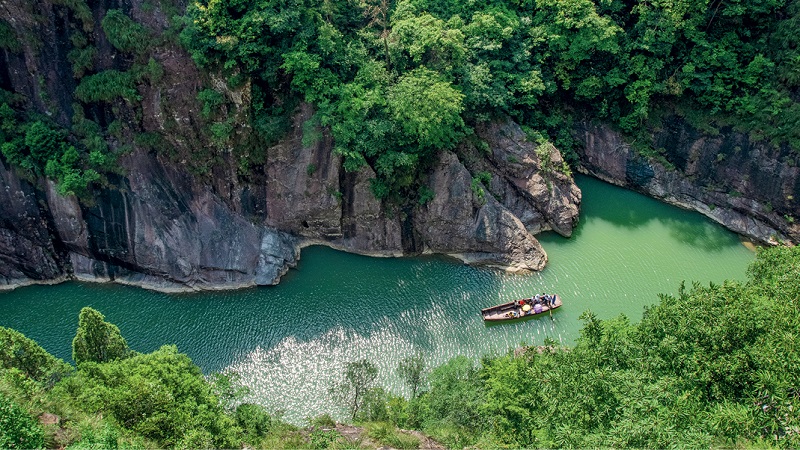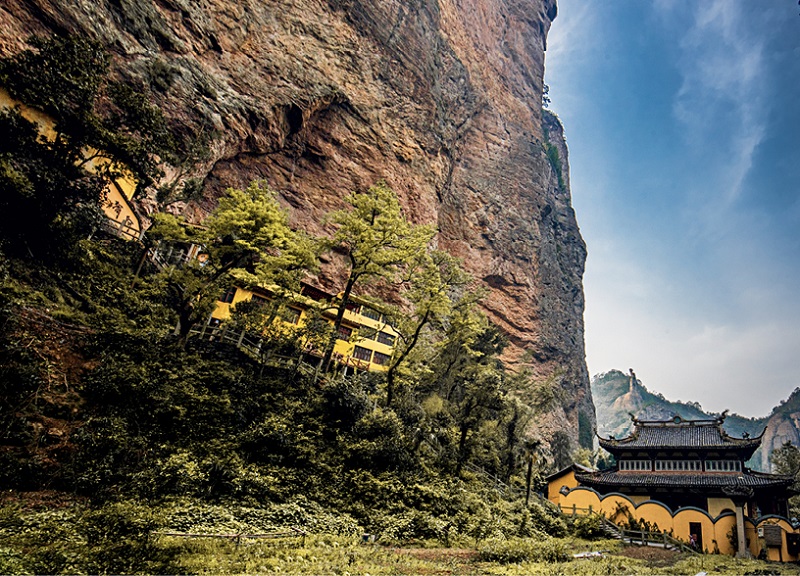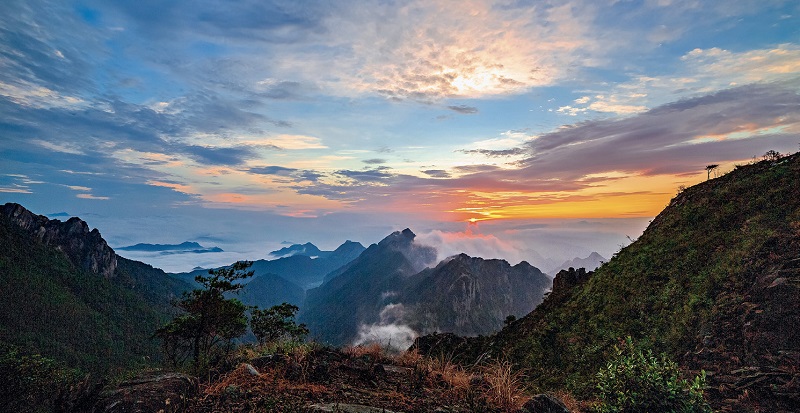
Visitors enjoy taking a boat ride through the gorge of the Yandang Mountain.
The Yandang Mountain Scenic Area is mostly located in Yueqing City of southeast China’s Zhejiang Province, with some sections in Yongjia County and Wenling City. It lies nearly 300 kilometers from Zhejiang’s provincial capital Hangzhou. It covers a total area of 450 square kilometers with its highest point being Baigangjian Peak reaching an elevation of 1,056.5 meters. This scenic area boasts over 500 attractions spreading across eight sub-scenic areas, which are notable for exotic-looking peaks and rocks, ancient caves, stone chambers, as well as springs and waterfalls. Among them, Lingfeng, Lingyan, and Dalongqiu are known as the three must-visit areas. Abundantly endowed with natural beauty, the Yandang Mountain is recognized as a national AAAAA scenic spot, a national forest park, and a Global Geopark.
The Yandang mountain range was formed 120 million years ago and endured four major volcanic eruptions which led to the formation of its magnificent landscape and also made it a natural window for exploring the magmatism and geology of the Asian continental plates underneath. Yandang has a subtropical oceanic climate featuring abundant rainfall and warm weather year-round.

Yandang Mountain boasts age-old historical landscapes.
Lingfeng Peak
The main attractions of the Lingfeng scenic area are Guohe Bridge, Guanyin Cave, and Beidou Cave. Shortly after entering the scenic area, visitors come across the Guohe Bridge, a stone arch bridge over the Ningbi Pool. The bridge is connected with the Guohe Rock on one end and thus the name “Guohe” has been given to it. The bridge, pool, and rock altogether are known as the “Guohe Trio,” and present a serene vibe. Strolling across the Guohe Bridge, visitors can gaze up at the surrounding majestic hills and enjoy views of turquoise water under the bridge. The Guohe Rock is a large oval-shaped stone with a ring-shaped mark in the center, making it look like a fruit box – which is why it is called Guohe (literally meaning “fruit box” in Chinese). On the rock, there is a wooden pavilion that has a hexagonal roof, which is a wonderful place for tourists to rest and enjoy the scenery.
Further ahead lies an ancient cave formed by earthquakes. It contains seven smaller caves that are connected to each other. Climbing up the stone steps inside the cave, tourists can check out the East and West Yaotai platforms to get a great view of the hills in the scenic area. Many fantasy dramas were filmed at this spot for the exotic setting, and it is also an ideal place for photo-graphy enthusiasts. Looking east, there is a wide canyon between towering cliffs. In the west lies one of the scenic area’s star attractions, the Hezhang Peak.
From the Yaotai platforms, tourists can go directly to visit the Hezhang Peak (literally meaning “Palms Together Peak”). Also known as the Fuqi Peak (literally meaning “Husband and Wife Peak”), it is a must-see attraction which resembles different shapes when observed from different viewpoints, such as a hugging couple or an eagle spreading its wings. The Hezhang Peak can actually be considered as two conjoined peaks: the right side is the “Ling Peak” while the left is called the “Yitian Peak.” The highest point is about 270 meters high, and the gap between the two peaks forms a cave, called the Guanyin Cave. The cave is 113 meters high, 76 meters deep, and 14 meters wide, and is home to a nine-storey temple. It was first used as the residence of the monk Shanmu in the Tang Dynasty (618-907), and then later built into a Buddhist temple. In the Song Dynasty (960-1279), 500 arhats were sculpted on the rock. From the foot of the peaks, there are 403 meandering stone steps to climb up to reach the main hall on the top floor. In the center of the main hall is a statue of Guanyin, the Bodhisattva of Compassion, with 18 arhats sta-tues standing beside it. Looking out from the hall, visitors can behold a unique view of the surroundings through the narrow and long gap between the peaks.
The Beidou Cave is the largest Taoist shrine in the Yandang Scenic Area. The tall and spacious entrance of the cave allows it to receive copious amount of daylight, making it warm in winter, and cool in summer. The main architectural structures within the cave include the four-story Lingxiao Hall, the three-story Baxian Building in front, and the main hall in the rear. On the left side of the cave’s roof, there are a number of pieces of cyan rock embedded in the black rock. Connected piece by piece, they look like the scales on a dragon’s abdomen, and thus that cluster of rocks is called “the Crouching Dragon.” Inside the cave, there are similar formations such as “Golden Jade Rabbit,” and “Frog Hanging Upside-down.” There is a spring on the lower left side of the cave, commonly referred to as the “Dragon Well.” Crystal-clear spring water seeps out from the rocks and does not falter even in winter.
The night tour is an exceedingly popular activity in the Lingfeng scenic area. Its highlights are the shifting silhouettes of the hills in moonlight, including those resembling rhinos looking at the moon and whales spouting water.

A gorgeous mountain scene begins to come into view as the sun rises over the horizon at the Yandang Mountain.
Dalongqiu Waterfall
The Dalongqiu scenic area is famous for its natural scenery of gorges, waterfalls, and cliffs. As soon as visitors enter the scenic area, they find themselves surrounded by towering lush mountains on both sides. Walking along the river makes it easy to get immersed in the lush landscape, where hikers reach the Dalongqiu Waterfall in a short while.
As one of the four major waterfalls in China, Dalongqiu flows down from the top of a 190-meter-high cliff, and its water flow varies in behavior during different seasons. In autumn, it appears to descend from the sky with the elegance of a thin veil. On a clear winter day, it transforms to a string of loose beads. In spring, Dalongqiu takes on a different look as it splashes down from the top and turns into mist within the drop of less than a few feet. However, during the summer peak – as thunderstorms roll through – Dalongqiu becomes an angry silver dragon, swooping down from mid-air and shaking the sky and the earth. The water body below the waterfall is emerald green and looks like green jade, complementing the waterfall above. Watching the slim waterfall cascade down from the high cliffs into a clear green pond and the water vapor suffuse the air, makes those witnessing the scene feel like they have been transported to a fantasy world. Xu Xiake, a prominent travel writer and geographer of the Ming Dynasty (1368-1644) wrote, “The waterfall of Longqiu plunges into the pool.”
In addition to the waterfall, there are also attractions featuring stones and hills in vivid shapes such as a pair of scissors, a mast, a woodpecker, and a bear.
Lingyan Peak
Inside the Lingyan scenic area, the first attraction is the Pingxia Peak whose wide cliff is hundreds of feet high. Continuing forward is the Lingyan Temple, named after the Lingyan Peak, and is one of the most famous ancient temples in Yandang. Built in the Song Dynasty, the temple had more than 100 rooms and housed 1,000 volumes of sutras in its heyday. It was rebuilt after several wars. Nestled in the arms of surrounding mountains – along with the Wolong Stream running through its gate and the Pingxia Peak at the back – the temple effuses a tranquil Zen vibe.
There are several attractions around the temple. In front of the right side of the Lingyan Temple is the Tianzhu Peak, which resembles a huge stone pillar that reaches a height of 266 meters. The Zhanqi Peak is in front of the Lingyan Temple on the left, opposite to the Tianzhu Peak. It is about 260 meters high, and looks like a large fluttering flag. There is a small waterfall called Xiaolongqiu at the bottom of the Yinlong Peak behind the Lingyan Temple. Climbing up the winding trail behind the temple, visitors can find the Longbi Cave, which has more than 80 cliff inscriptions of the past dynasties, and hence has long been a place for the literati to pay homage to.

A group of visitors are experiencing a thrilling mid-air climbing activity at Taping Peak of the Yandang Mountain.
Historical Landmarks
The Yandang Mountain culture is steeped in history. The building of religious architecture and sacred sites started during the Southern and Northern Dynasties (420-589), began to boom in the Tang Dynasty (618-907), and flourished in the Song Dynasty (960-1279).
The peculiar landscape of the Yandang Mountain has attracted numerous literati and artists who left a large number of works – including more than 5,000 poems, more than 400 cliff carvings, and a number of historical landmarks like pavilions, towers and memorial gates and arches.
Ming Dynasty explorer Xu Xiake visited the Yandang Mountain three times and wrote a 7,000-word diary under the title of “Tour of the Yandang Mountain.” In the writing, he depicted the stunning sceneries through engaging and richly textured writing. According to Xu’s documentation, he finally identified the sources of Dalongqiu and Xiaolongqiu waterfalls after trekking through dense woods, climbing dangerous cliffs, and even escaping from dire dangers. His diary is both a precious document in geography and a literary travelogue replete with superb writing, inspiring countless tourists to visit and experience the area throughout ages.